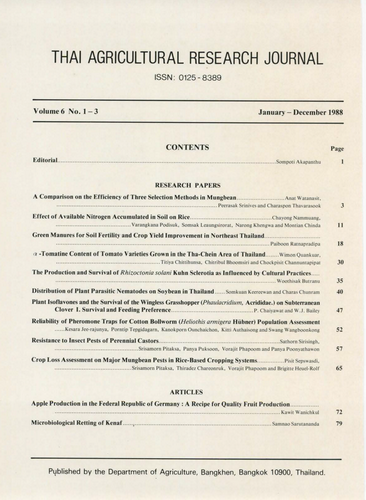EFFECT OF AVAILABLE NITROGEN ACCUMULATED SOIL ON RICE
Abstract
Relationships between analytical values of accumulated N and yield of rice grown in a Nakhon Pathom clay loam (Aeric Tropaqualfs) soil were studied in pot experiments. Using a CRD 6 levels of N at 0, 30, 60, 90, 120 and 240 ppm N, respectively, even applied and mixed with the soil under slurry conditions. The N treated soil was submerged and maintained under fooded conditions for 35 days. Available soil N under both flooded and dry soil conditions was determined, together with the yield of rice grown with a yield-maximizing level of N which was determined from on the yield production equations and the actual amount of available N present in the soil. The results indicated that the available N accumulated in the soils can be increased by the addition of N-fertilizer. However, the quantity of available N accumulated in the soil was dependent on the percentage of N loss and the amount of N applied to the flooded soil. NH+4 -N accumulated in greater amounts than the NO-3 -N in submerged soils; in dry soils under warm conditions the revese was true. However, in dry soils under very hot, conditions, the NH+4-N was found in greater amounts than NO-3-N. These studies indicate that available N accumulated in the soil can be considered as making a contribution to the N requirements of the rice crop when formulating N fertilizer recommendations. It also appears that the available N accumulated in the soil is more efficient in increasing rice yield than an equal amount of N obtained from applied N-fertilizer.
Downloads
Published
How to Cite
Issue
Section
License

This work is licensed under a Creative Commons Attribution-NonCommercial-NoDerivatives 4.0 International License.
Thai Agricultural Research Journal



